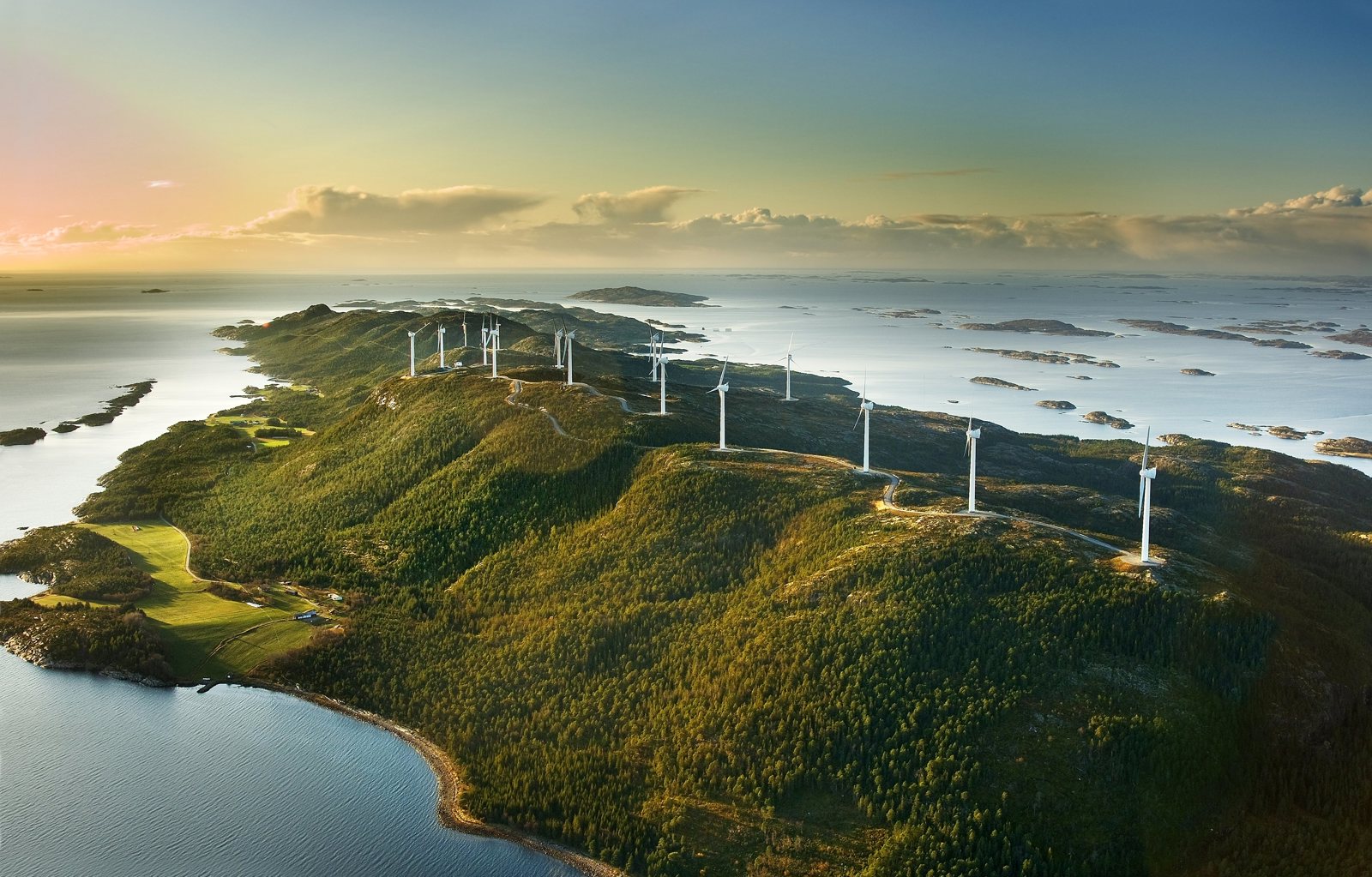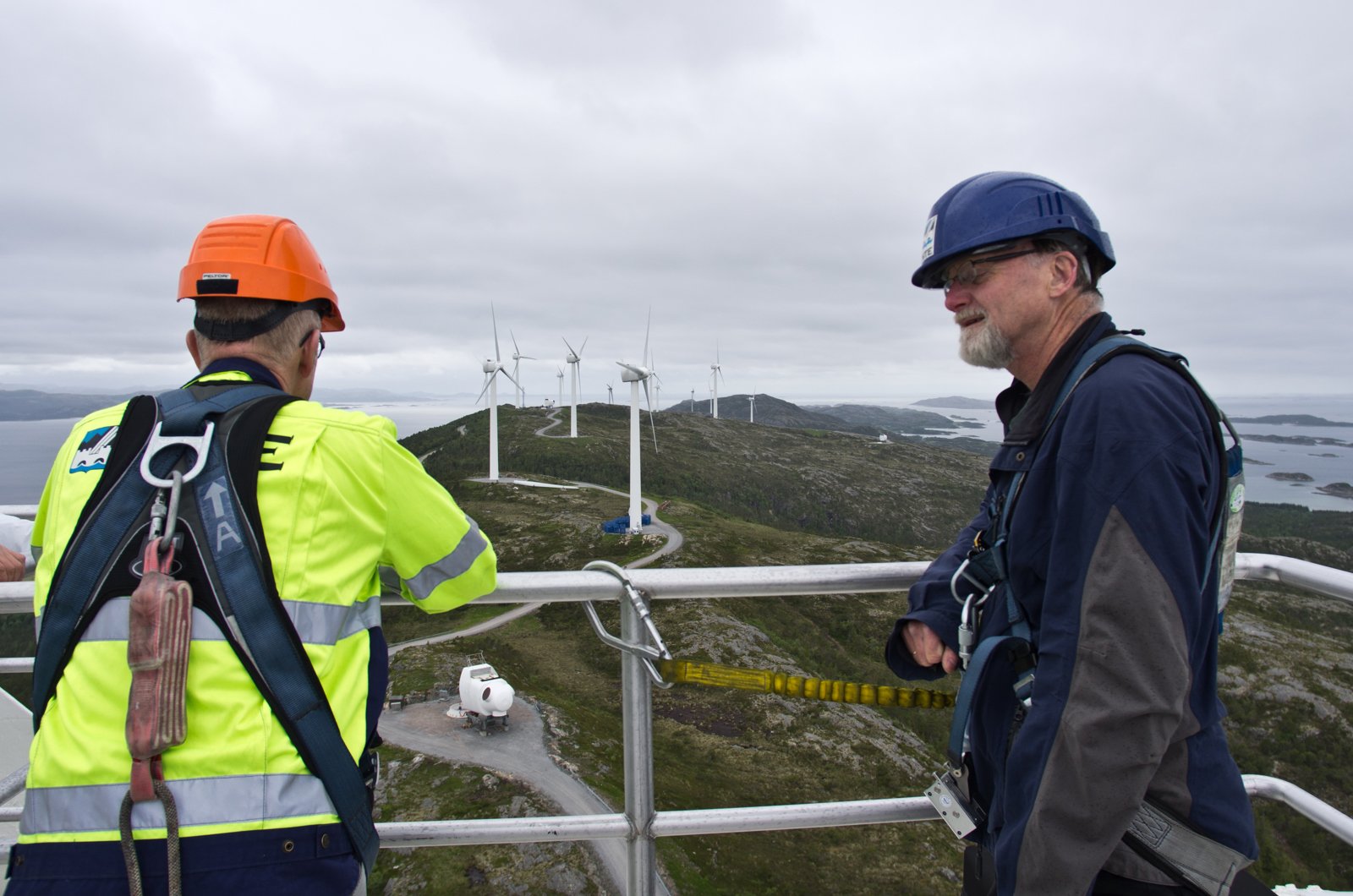
Kongsberg Maritime's new target is the efficient control of wind parks. This new technology is to be tried and tested for the first time at the Hundhamarfjellet wind park in Nord-Trøndelag.
-
Text:CHRISTINA FJELLSTAD
-
Ove Ronny HaraldsenGroup Communication Manager
A narrow lift with barely space for three persons creeps slowlyup through a narrow cylinder. The lift rocks gently from side to side but that is nothing compared to the movement when it reaches the top of the cylinder and you climb precariously out onto a tiny platform 80 metres above the ground and fasten yourself to the railings with a carabiner. The platform may not be that high up but it is most definitely narrow and airy and allows you breathtaking views of the rugged landscape of the coast of Nord-Trøndelag. The vast white wings of the turbine whisk slowly past, driven by the wind which is nowhere near its full strength. This area has been chosen for its exposure to strong winds. Without wind, the white turbine blades which generate power for around 8,500 households would not be able to turn.
ROCKY FOUNDATIONS
Hundhamarfjellet wind park is located on the Abelvær peninsula in Nærøy municipality. The first wind turbine was built there in 1998 and the park now has 17 turbines generating a total 175 GWH of electricity every year. Each turbine weighs 509 tons and the 43-metre long blades each weigh a total of ten tons. Despite their immense weight and exposure to the strong coastal winds, the turbines have their feet planted firmly on the rocky ground, with 22 piles submerged 15 metres into the ground.

“The wind turbines start to operate when the wind strength reaches 3 metres per second, and power production will vary according to wind. The turbines reach maximum production with a wind strength of 13 metres per second. However, if the wind strength exceeds 25 metres per second, the turbines shut down for safety reasons,” explains Operations Manager at the wind park, Inge Hestad.
WINDSENSE
The wind park is owned and run by Nord- Trøndelag Elektrisitetsverk (NTE), an energy utility company that is owned by North Trøndelag County Council and which supplies power to Central Norway. K-Magazine visited the wind park to take part in a guided tour for representatives of the so-called Windsense project, a project owned by Kongsberg Maritime represented by Oddbjørn Malmo. Windsense is a cooperation between a number of the largest companies involved in the wind power cluster in Central Norway. The Research Council of Norway has subsidised the project with NOK 10 million or 40% of the total project funds of NOK 22 million. The project, initiated by the NCEI (Norwegian Centres of Expertise and Instrumentation), has been set up to find solutions by which wind power can become more financially competitive on a market willing to invest substantially in renewable energy.
“The project’s goal is to make wind turbines more efficient by reducing the number of unscheduled shutdowns. We plan for example to develop systems which will allow provisional operation of the turbines at lower capacity while waiting for maintenance. We also aim to generate as much power as possible from the turbines we currently have available,” explains Oddbjørn Malmo.
NEW DEPARTMENT
Kongsberg Maritime not only owns the project but has established wind power as a significant target area. The company plans to develop systems for monitoring and operating wind parks. As such, they have set up a whole new department for “Wind Park Management”, financed by Kongsberg Gruppen. To date, this department has 12 employees and will be located in Lade in Trondheim where they already have many years of experience in developing sensors for the maritime industry. The new department is seeking to make use of this experience for the wind power market.
“The experience we have gained from the maritime industry can undoubtedly be transferred to the wind power market. The systems we plan to develop are not new. You could compare them to systems KONGSBERG develops for integrated ope rations on oil platforms,” explains Andreas Jagtøyen, Vice President, Merchant Marine, Trondheim. “Due to the harsh climate in the areas where the turbines are installed, like Hundhamarfjellet mountain, the wind parks may not always be accessible. Any shutdowns will cost the park owners a lot of money, and good surveillance and automation systems will therefore be of great benefit for the operation of wind parks. It would mean that the operational organisation does not have to share the same location as the wind turbines but continue to ensure optimal operation of the turbines according to wind and weather conditions,” he states.
TARGETING LONG-TERM GROWTH
The Hundhamarfjellet installation is one of 19 wind parks in Norway which in total only generate one percent of the total national power supply. According to the so-called Renewables Directive, all EU countries are obliged to increase domestic production of renewable energy. By 2020, the share of renewable energy related to total energy consumption in EU countries shall be increased to 20 percent. As a member of the EEA, Norway is governed by this Directive. Norway has set itself a target to increase its share of renewable energy to 67.5 percent by the end of 2020. Wind power will play a central role here and four new wind parks are already under development.
“Norway has good weather and wind conditions to help us achieve the objectives laid down by the EU, and this is particularly the case in Central Norway where there is high potential for the development of wind parks. The new Directives have opened the doors to a larger market for wind turbine power and related systems. We want to take part in this development and to play a central role for both onshore wind turbines and offshore, which represents a large share of the market,” explains Mr. Malmo.

GLOBAL WIND POWER
Today, wind power comprises more than 10 percent of the total installed energy capaci ty in the EU. Germany has the highest level of wind power in Europe, followed closely by Spain, Italy and Great Britain, while Denmark has the most wind power in relation to other electricity production. North America and Asia have also joined the market for wind power, and Asia is currently and without a doubt the largest market for new capacity. In 2010 and for the first time, the largest capacity was installed in what is known as “emerging economies”, with China leading the way. Latin America has also made investments in wind power in recent years with significant developments and a rapid growth projected for the near future. 80 countries worldwide have wind power and the total capacity is expected to double every three to four years up to 2020.
“The immense rate of development in wind power means that the time is right to target this market. Somewhere between 15 to 20,000 wind turbines will be manufactured every year up to 2020 and we intend to have our systems available when all these new wind turbines are ready for operation. This is an important area for us, but our systems will also be important for the wind power market. Wind parks of the future will also have larger and more turbines, so our wind park management systems will be all the more appropriate,” explains Mr. Malmo.
OPPOSITION TO WIND POWER
Investments in wind power are also environmentally important. Production at the Hundhamarfjellet park alone represents a reduction in CO2 emissions of 140,000 tons per year when compared with imported coal-fired power production. This corresponds to the emissions from around 40,000 cars. However, despite wind power being a renewable source of energy and with no emissions, it is something new in Norway and has been met with a certain amount of opposition. The main objections are that the wind turbines may have a negative impact on bird life and fauna and may generate noise problems and shadow for built-up areas. Other objections are that the wind parks spoil the landscape. Moreover, as wind power varies, the parks will have irregular power production and will require traditional power plants in reserve.
“Our investments in offshore wind turbines will help appease some of the opposition to wind power, partly because they do not represent a nuisance for locals. Wind turbines are also reversible and can be removed without leaving a noticeable mark. What’s more, our systems will help ensure optimal operations, minimising irregular production and the need for reserve systems,” explains Mr. Malmo.
ENHANCED SAFETY
In addition to a more regular rate of production, lower power costs and the general environmental benefits provided by wind power, Kongsberg Maritime’s systems for Wind Park Management will provide improvements in the safety of operations. “With our systems, maintenance can be based from one operations centre where you monitor the technical condition of the wind turbines and the life cycle of all the different components in use. This will allow us to accurately predict when the systems require replacement. Normally, this type of work is carried out by operators using handheld measurement instruments. This kind of work can be quite dangerous due to the strong winds in areas like Hundhamarfjellet mountain,” says Mr. Malmo.
We can confirm this statement, perched at the top of a wind turbine in a relatively weak wind. But this will all change when the new systems have been developed by Kongsberg Maritime. For now, the participants in the Windsense project can unhook their carabiners and climb back into the tiny lift to be lowered safely back to ‘terra firma’ and fly back to their respective homes, which will over the years be heated more and more by wind power.

